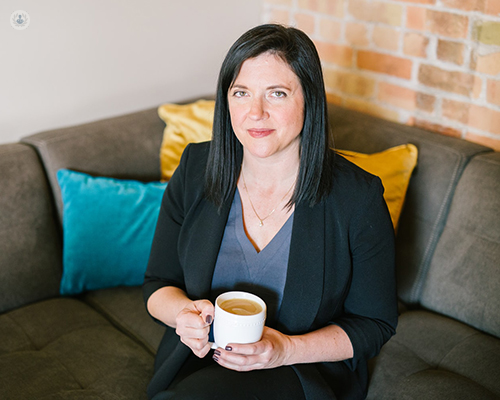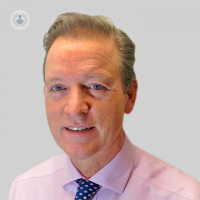What to expect before and after therapeutic mammoplasty
Written by:Therapeutic mammoplasty is a surgical technique that preserves the breast, if it is oncologically possible, by removing cancer and reshaping the breast using its skin and tissue to preserve a normal shape. Understandably, if you have been told that you need to have the procedure, you must be wondering what happens each step of the way from consultation with your surgeon to recovery.
We talk to one of our highly-experienced oncoplastic breast surgeons Mr Brendan Smith about what his patients can expect on the day of their therapeutic mammoplasty surgery under his care and what happens after the operation.

What can I expect before the operation?
On the morning of surgery, I will ask you to sign a consent form agreeing to the operation. I then make some pen markings on your breast to plan out the operation. I will take some photographs that are non-identifiable without your face appearing in the images. You will also meet the anaesthetist.
If the tumour is difficult to feel you may need to go down to the X-ray department before the surgery. The X-ray doctors will need to localise the tumour and put a guide-wire into it whilst you are under local anaesthetic. This shows us surgeons which breast tissue is to be removed.
The operation may also involve surgery to your lymph glands in your armpit that will have been discussed with you before.
To perform the operation, the tumour and a margin of tissue around it are removed first. Then the breast is reshaped with the nipple repositioned. The full extent of surgery depends on the technique being used, and this will be discussed with you in the clinic.
What can I expect after my therapeutic mammoplasty?
You will go back to the ward where we will give you painkillers, some water initially and hopefully soon after you will be ready for something to eat. You may need some minor help initially to get out of bed for the first time.
You will need to take regular painkillers following surgery (no Nurofen, Ibuprofen or other non-steroidal anti-inflammatories for 48-hours post-surgery).
You may experience some shooting pains in the breasts that will ease over the next few months. The breasts will be swollen and your nipple sensation may be altered or lost.
The early swelling and bruising subside in around six weeks but can take up to 6-12 months for the scars and shape of the breasts to settle.
How do I look after the wound?
Your wound will be covered with a waterproof dressing to keep it clean. You can shower the day after surgery. There is sometimes some discharge from the wound when you are at home. Do not be alarmed, but if you have concerns please contact our breast care nurse for advice or the ward if outside normal working hours. Your stitches are dissolvable.
What signs should I watch out for after surgery?
If you feel unwell with a temperature, vomiting or notice significant redness of the skin on or around the breasts, you should either contact our breast nurse specialist, my secretary or (if out of normal working hours) the ward. This is because you may have an infection and will need antibiotics. Wound infections often do not develop until more than one-week post-surgery.
Sometimes fat necrosis is mistaken for an infection, with redness and swelling but you are not unwell and there is no wound discharge.
Bio-oil should not be applied to the wound until six weeks after surgery.
What other things will I be advised?
I will explain the following tips to my patient:
Supplements
Please do not take any health food supplements before or immediately after your operation. Please notify your surgeon before surgery if you are taking anything (e.g Arnika).
Bras and prosthesis
You should wear a soft supportive bra with no under-wiring immediately after the operation. This helps prevent the weight of the breasts pulling on the wounds and affecting the healing process. You should wear the supportive bra for four to six weeks day and night, only taking it off to shower. If there is a significant difference in size, it may be necessary to wear a partial prosthesis in your bra. This can be discussed with your breast care nurse who will advise you about fitting clinics.
Time off work
The length of time you need to take off work depends on the nature of your job but you will need at least to plan for two to four weeks. Please ask if you require a sickness certificate for work and this will be given to you before you leave the hospital.
Resuming normal activities
You will need to avoid strenuous exercise for a minimum of six weeks. You are advised not to have sex for the week following the surgery as sexual arousal can cause further swelling of the breasts. Allow only gentle and minimal contact with your breasts for about six weeks. Driving will not be allowed for at least two weeks following surgery and only when you can safely perform an emergency stop. You must avoid heavy lifting, housework and carrying heavy shopping.
Exercise
You will be given an exercise sheet but do not undertake these exercises for 10 days following the surgery. In the unlikely event that you have problems with shoulder or arm stiffness, we will refer you to the physiotherapist. It is important not to take any health supplements 10 days before and after surgery as some can increase the risk of complications.
If you would like to discuss your surgical options for breast cancer you can book an appointment with Mr Smith via his Top Doctor’s profile here for his expert opinion.


